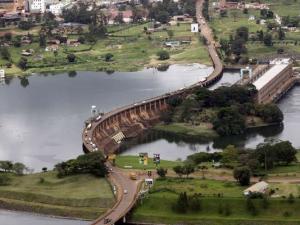
Uganda drains excess dam water into the Nile
The Kiira and Nalubaale hydro stations in Jinja are spilling out more water into the River Nile, at a time when Egypt is battling with Ethiopia over the river’s water flow.
The battle over Ethiopia’s 6,000MW Renaissance dam recently moved to the US, with Washington arbitrating between the two countries with no success so far.
South African electricity generator, Eskom Uganda Ltd, operating the Kiira and Nalubaale power stations, has for the first time opened the spillway gates to let excess water drain out of Jinja dam as a safety measure for its own operations, downstream human settlement and to safeguard Bujagali and Isimba dams downstream.
Eskom officials told The EastAfrican that the effects of the water spillage will not be immediate. “The effects will be felt in Egypt after about three months,” said Peter Tentena, operations manager at Eskom.
The dam has reached its peak limit of 12.91 metres, which is four centimetres away from the warning limit of 12.95 metres, occasioned by heavier than normal rains experienced in the Lake Victoria catchment areas since 2019. On request by Eskom, Uganda’s directorate of water resources management, a body mandated under the Water Act 1998, issued the permit for water release of up to 400 cubic metres per second, equivalent to an Olympics swimming pool.
BUJAGALI, ISIMBA TO SPILL
With water levels rising, the question over 250MW Bujagali Hydropower project’s safety becomes critical, being only 13.8km away from Nalubaale and Kiira dams, meaning it will see the consequences of the spilling immediately.
Bujagali will also be required to spill to avoid flooding and a back-flow to Nalubaale and Kiira dams. Same spilling will have to be done at the 183MW Isimba plant.
“Demand for electricity has not increased to enable us utilise the water for production, so our production is same as before. That means that even Bujagali will also have to spill the excess water,” said Mr Tentena
“The exercise won’t impact power generation; the same dispatch regime shall be maintained as was before the spill. The water being spilled doesn’t contribute to power generation. If the demand was higher, Eskom would be able to generate more power, and less water would be spilled. That is the reason that we spill more water during periods of low demand, and less water during periods of high demand,” said Mr Tentena.
Eskom has been producing 140MW on average from the two dams, which is below the installed capacity of 240WM.
The increased water flow is expected to affect fishing, lake side farming and leisure activities on the river.
